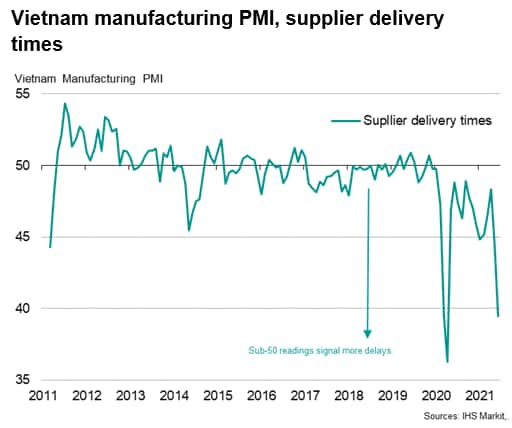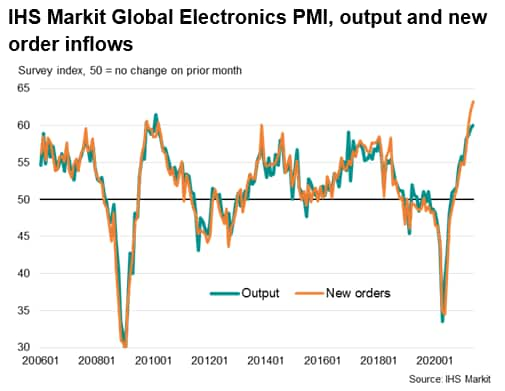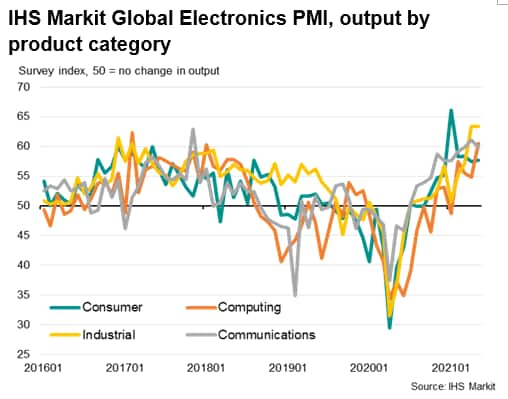Vietnam Economy: New Covid-19 Wave Creates Downside Risks to Near-Term Outlook
Vietnam was one of the most resilient economies in the Asia-Pacific region to the shockwaves from the global Covid-19 pandemic during 2020. Strong economic recovery continued in the first half of 2021, with GDP in the second quarter of 2021 rising by 6.6% year-on-year.
However, after considerable success during 2020 in containing daily new domestic Covid-19 cases to low levels, the situation has deteriorated in May and June 2021, with a significant pickup in reported daily new cases. With Covid-19 vaccination rates still remaining very low as a share of the total population, Vietnam remains vulnerable to a rising and protracted Covid-19 wave. The latest IHS Markit Vietnam Manufacturing PMI for June 2021 showed a sharp drop, reflecting the impact of the rising Covid wave.
New COVID wave poses downside risks to Vietnam's economy
Vietnam has been one of the world's fastest growing emerging markets in the past decade, boosted by strong foreign direct investment inflows into its manufacturing sector. The pace of economic growth slightly exceeded 7% in both 2018 and 2019. Rapid growth of manufacturing exports and large new inflows of foreign direct investment have been important growth drivers for Vietnam, notably driven by rapid expansion in the textiles and electronics sectors. Total electronic and electrical manufacturing exports accounted for 33% of total merchandise exports in 2019, with textiles, clothing and footwear accounting for a further 19.4%.
Total foreign direct investment inflows reached USD 20.4 billion in 2019, up 6.7% year-on-year, driven by strong investment by multinationals in establishing new manufacturing production facilities in Vietnam. Samsung has been a key investor, with total foreign direct investment into Vietnam of around USD 17 billion in the decade to 2018. Vietnam has become the biggest foreign production hub for Samsung Electronics, which booked USD 66 billion of sales in 2018 out of its Vietnamese operations, which was equivalent to around 28% of Vietnam's GDP. Around 50% of Samsung's smartphones and tablets are produced in Vietnam and exported globally. Samsung Vietnam has also built its largest R&D centre in Southeast Asia near Hanoi.
However, economic growth momentum moderated significantly in 2020, due to the impact of the COVID-19 pandemic. For calendar 2020, the Vietnamese economy grew by 2.9% y/y, compared with a 7.1% GDP growth rate in calendar 2019. Despite the moderation in growth momentum, Vietnam was one of the very few industrial economies in the Asia-Pacific region that achieved positive GDP growth in 2020. IHS Markit estimates that the Vietnamese economy will show improving growth momentum in 2021, expanding at a pace of 5.5% year-on-year. Disbursed FDI remained resilient in 2020 despite the pandemic, at around USD 20 billion, down only 2% on 2019. However, FDI commitments fell more sharply, by 25% y/y, to USD 28.5 billion.
Economic growth momentum has strengthened in the first half of 2021. GDP growth in the second quarter of 2021 up 6.6% y/y, improving on the 4.5% y/y growth recorded in the first quarter of 2021. A key driver of economic growth momentum has been the rapid growth of exports, which rose be 28.4% y/y in the first half of 2021. The strong performance of industrial exports also boosted the industrial sector, with industrial production up 9.3% y/y in the first half of 2021. FDI inflows in the first half of 2021 remained resilient, at USD 9.2 billion, up 6.8% y/y.
However, a pickup in daily new COVID-19 cases during May and June has created risks to the near-term outlook. A key concern is the low COVID-19 vaccination rate in Vietnam, which leaves the nation vulnerable to further rises in daily COVID cases until vaccination levels increase substantially. Only 3.3% of the total population had received a first vaccination by 27th June 2021, while the fully vaccinated share was extremely low, at just 0.2% of the population. As a result of the rising COVID wave, the government authorities have put in place strict lockdown restrictions for Ho Chi Minh City for a wide range of activities, including on public transport and public gatherings, as well as non-essential business activities.
COVID wave impact on manufacturing sector
The latest wave of COVID-19 cases in Vietnam led to a sharp decline in business conditions for manufacturers during June. The IHS Markit Vietnam Manufacturing Purchasing Managers' Index (PMI) plummeted to 44.1 in June from 53.1 in May, pointing to the most severe deterioration in business conditions for over a year and ending a six-month period of growth.
Output and new orders both decreased at the sharpest rates since the first outbreak of the pandemic in early-2020, while firms scaled back their employment and purchasing activity accordingly. The pandemic also impacted supply chains, resulting in a near-record lengthening of delivery times. For example, four industrial parks in Bac Giang province in northern Vietnam were temporarily closed in late May, due to outbreaks of COVID cases, which also impacted on some manufacturing facilities of Foxconn and Samsung.

The COVID-19 pandemic, lockdown measures and temporary company closures were all mentioned by firms participating in the survey as factors leading to sharp reductions in both output and new orders during June.
However, despite the deterioration in manufacturing conditions in June, Vietnam's exports performed strongly during the first four months of 2021, prior to the escalation of the current COVID wave. According to Vietnam's General Statistics Office, exports in the first four months of 2021 are estimated to have risen by 29.6% y/y to USD 104.9 billion, while imports likely increased 31.8% y/y to USD 103.3 billion, resulting in a trade surplus of USD 1.6 billion for the first four months of 2021.
In the near term, Vietnam's exports have shown rapid growth, as key export markets, notably the US, China and EU, roll out COVID-19 vaccines, allowing a gradual recovery in economic growth momentum. This has supported a rebound in new orders for key Vietnamese exports such as garments and electronics. Vietnam's exports to its largest export market, the US, rose by 48% y/y in the first four months of 2021, while exports to China rose by 28% y/y over the same period.

Although Vietnam's merchandise exports were very resilient in 2020 and have rebounded in the first half of 2021, exports of tourism services have collapsed since March 2020 due to the impact of international travel bans, including Vietnam's own ban on international travel. Prior to the pandemic, the tourism economy had been growing strongly in recent years, with international tourist visits to Vietnam in 2019 having reached 18 million trips, up 16% y/y. The protracted disruption of international tourism has hit Vietnam's service sector exports badly in 2020-21. The impact on the overall tourism economy has been mitigated by the significant contribution of domestic tourism to the overall industry while the domestic pandemic had very low daily cases. However, with the rising COVID wave and new restrictions, domestic tourism activity is also being hit.
Electronics Sector hit by global demand slump
A key factor that has driven the sustained strong growth of Vietnam since 2010 has been the rapid growth of electronics manufacturing. The importance of Vietnam's electronics industry has risen dramatically, with the electronic industry's share of total GDP rising from around 5% in 2010 to around one- quarter of GDP by 2019, a key factor helping to drive rapid growth of both exports and GDP.
With electronics now being Vietnam's most important export sector, the impact of global lockdowns due to the pandemic on the global electronics industry had been a key shock to the sector during the first half of 2020. Amid widespread global lockdown measures aimed at containing the spread of the pandemic, world demand for electronic goods slumped sharply in the second quarter of 2020.
However, since the low points in April and May 2020, the IHS Markit Global Electronics PMI has signalled a very significant rebound. The latest IHS Markit Global Electronics Purchasing Managers' Index for May 2021 reached the highest level recorded in 23 years, boosted by buoyant demand in key markets. Rebounding consumer spending and industrial production in key economies, notably the United States, mainland China, the European Union, and the United Kingdom, is helping to drive demand for a wide range of electronics products.
According to the PMI data, global electronics new orders rose from a calendar year-to-date low of 34.7 in May 2020 to a level of 63.3 in May 2021. New orders in May showed the fastest pace of expansion since May 2004 and were the fourth-fastest pace of expansion since the survey series began 23 years ago.


Vietnam's exports from phones and components were up 30.7% y/y in the first four months of 2021. Meanwhile exports of personal computers and related products rose by 18.2% y/y, as the global shift to remote working boosted demand for personal computers. Vietnam has significantly increased its share of global exports of computers in the past five years and is now competing with China in terms of the total export value of computer products.
Medium term growth drivers
The pandemic is expected to recede during 2022 as vaccination rollout becomes more widespread across the population of Vietnam. Over the medium-term outlook for the next five years, a number of key drivers are expected to continue to make Vietnam one of the fastest growing emerging markets in the Asian region.
Firstly, Vietnam will continue to benefit from its relatively lower manufacturing wage costs relative to coastal Chinese provinces, where manufacturing wages have been rising rapidly over the past decade.
Secondly, Vietnam has a relatively large, well-educated labour force compared to many other regional competitors in Southeast Asia, making it an attractive hub for manufacturing production by multinationals.
Third, rapid growth in capital expenditure is expected, reflecting continued strong foreign direct investment by foreign multinationals as well as domestic infrastructure spending. For example, the Vietnamese government has estimated that USD 133 billion of new power infrastructure spending is required by 2030, including USD 96 billion for power plants and USD 37 billion to expand the power grid.
Fourth, Vietnam is benefiting from the fallout of the US-China trade war, as higher US tariffs on a wide range of Chinese exports have driven manufacturers to switch production of manufacturing exports away from China towards alternative manufacturing hubs in Asia.
Fifth, many multinationals have been diversifying their manufacturing supply chains during the past decade to reduce vulnerability to supply disruptions and geopolitical events. This trend has been further reinforced by the COVID-19 pandemic, as protracted supply disruptions from China during February and March created turmoil in global supply chains for many industries, including autos and electronics.
For example, the Japanese government has introduced a subsidy program in 2020 for Japanese companies to help reduce supply chain vulnerability by relocating production out of China either back to Japan or to certain other designated nations. The Japanese government has allocated an estimated 220 billion yen for the supply chain reshoring program in Japan's supplementary budget for the 2020 fiscal year, equivalent to around USD 2.1 billion. An additional 23.5 billion yen were allocated for supply chain diversification to other selected countries, which includes ASEAN, India and Bangladesh. Vietnam has been one of the preferred destinations for Japanese firms choosing to shift their production to the ASEAN region in the first round of subsidy allocations announced by the Japanese government.
Free trade agreements
Vietnam is also set to benefit from its growing network of free trade agreements. As a member of the ASEAN grouping of nations, Vietnam already has benefited considerably from the ASEAN Free Trade Agreement (AFTA), which has substantially removed tariffs on trade between ASEAN member countries since 2010. ASEAN also has a network of free trade agreements with other major Asia-Pacific economies, most notably the China-ASEAN Free Trade Area which entered into force in 2010. This network of free trade agreements has helped to strengthen Vietnam's competitiveness as a low-cost manufacturing export hub.
The EU-Vietnam FTA (EVFTA) is a key new free trade agreement that will boost Vietnam's exports and foreign direct investment inflows. The EVFTA is an important boost to Vietnam's export sector, with 99% of bilateral tariffs scheduled to be eliminated over the next seven years, as well as significant reduction of non-tariff trade barriers. For Vietnam, 71% of duties were removed when the EVFTA took effect on 1st August 2020. Vietnam's exports to the EU rose by 21% y/y in the first four months of 2021. The scope of the EVFTA is wide-ranging, including trade in services, government procurement and investment flows. An EU-Vietnam Investment Protection Agreement has also been signed which will help to strengthen EU foreign direct investment into Vietnam when it is implemented.
Vietnam will also benefit from the Regional Comprehensive Economic Partnership (RCEP) free trade agreement. The 15 RCEP countries are the ASEAN ten nations, plus China, Japan, South Korea, Australia and New Zealand. The RCEP agreement covers a wide range of areas, including trade in goods and services, investment, e-commerce, intellectual property and government procurement.
US bilateral trade frictions
The U.S. deficit for trade in goods with Vietnam reached USD 55.8 billion in 2019, with the deficit widening by 41.2% compared to 2018. This was slightly mitigated by the USD 1.2 billion surplus in favour of the US for trade in services, but still left the overall bilateral trade deficit at USD 54.5 billion in 2019.
In 2020, the US trade deficit with Vietnam for trade in goods has further widened, reaching USD 69.7 billion.
Reflecting the persistent large bilateral trade surplus that Vietnam has with the US, the Office of the US Trade Representative (USTR) announced on 2nd October 2020 that the US government has launched an official investigation into acts, policies, and practices by Vietnam that may contribute to the undervaluation of its currency and the resultant harm caused to US commerce, under section 301 of the 1974 Trade Act.
As part of its investigation on currency undervaluation, USTR consults with the US Department of the Treasury as to issues of currency valuation and exchange rate policy. The US Treasury has informed the US Department of Commerce that Vietnam's currency was undervalued by 4.7% in 2019, partly due to intervention by the Vietnamese government. In December 2020, the US Treasury named Vietnam as a "currency manipulator".
USTR has also launched an investigation into Vietnam's acts, policies, and practices related to the import and use of timber that is assessed to be illegally harvested or traded.
However, in its April 2021 semiannual Report on Macroeconomic and Foreign Exchange Policies of Major Trading Partners of the United States, the US Treasury determined that with reference to the Omnibus Trade and Competitiveness Act of 1988, there was insufficient evidence to make a finding that Vietnam manipulates its exchange rate for either of the purposes referenced in the 1988 Act, and dropped its labelling of Vietnam as a "currency manipulator".
Nevertheless, consistent with the 1988 Act, the US Treasury considers that its continued enhanced engagements with Vietnam, as well as a more thorough assessment of developments in the global economy as a result of the COVID-19 pandemic, will enable the US Treasury to better determine whether Vietnam intervened in currency markets in 2020 to prevent effective balance of payments adjustment or gain an unfair competitive advantage in trade.
Economic outlook
The Vietnamese economy is expected to show improved annual growth in 2021, with GDP growth expected to strengthen to a pace of 5.5% y/y. Growth momentum is forecast to strengthen further to 6.8% y/y in 2022.
However, a key uncertainty in the near-term outlook is the extent and duration of the current wave of new COVID-19 cases that is hitting the nation. If the COVID wave escalates further, it poses a significant risk to the near-term outlook for domestic demand, with the added risk of disruption to manufacturing output if COVID-19 cases are detected in major manufacturing facilities or logistics supply chains. Furthermore, unless Vietnam can significantly ramp up its vaccination rate in coming months, it remains vulnerable to new COVID waves.
Despite these near-term risks, over the medium-term economic outlook, a large number of positive growth drivers are creating favourable tailwinds and will continue to underpin the rapid growth of Vietnam's economy. This is expected to drive strong growth in Vietnam's total GDP as well as per capita GDP.
Vietnam's total GDP is forecast to increase from USD 270 billion in 2020 to USD 450 billion by 2025, rising to USD 736 billion by 2030. This translates to very rapid growth in Vietnam's per capita GDP, from USD 2,800 per year in 2020 to USD 4,500 per year by 2025 and USD 7,000 by 2030, resulting in substantial expansion in the size of Vietnam's domestic consumer market.
Vietnam's role as a low-cost manufacturing hub is also expected to continue to grow strongly, helped by the further expansion of existing major industry sectors, notably textiles and electronics, as well as the development of new industry sectors such as autos and petrochemicals.
For many multinationals worldwide, significant supply chain vulnerabilities have been exposed by the protracted disruption of industrial production in China as well as some other major global manufacturing hubs during the COVID-19 lockdowns. This will drive the reshaping of manufacturing supply chains over the medium term, as firms try to reduce their vulnerability to such extreme supply chain disruptions. With US-China trade and technology tensions still remaining high, this is likely to be a further driver for reconfiguring of supply chains. A key beneficiary of the shift in global manufacturing supply chains will be the ASEAN region, with Vietnam expected to be one of the main winners.
Rajiv Biswas, Asia Pacific Chief Economist, IHS Markit
Rajiv.biswas@ihsmarkit.com
© 2021, IHS Markit Inc. All rights reserved. Reproduction in whole or in part without permission is prohibited.
Purchasing Managers' Index™ (PMI™) data are compiled by IHS Markit for more than 40 economies worldwide. The monthly data are derived from surveys of senior executives at private sector companies, and are available only via subscription. The PMI dataset features a headline number, which indicates the overall health of an economy, and sub-indices, which provide insights into other key economic drivers such as GDP, inflation, exports, capacity utilization, employment and inventories. The PMI data are used by financial and corporate professionals to better understand where economies and markets are headed, and to uncover opportunities.
This article was published by S&P Global Market Intelligence and not by S&P Global Ratings, which is a separately managed division of S&P Global.
